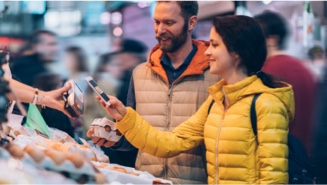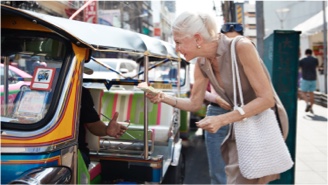Traveling abroad? Understanding payment methods and how to avoid transaction fees
Understanding the different ways of paying can save you money and help your trip run more smoothly
Read, 4 minutes
Hidden costs and fees on your various cards can add up quickly in a foreign country, whether you’re withdrawing money from an ATM, buying souvenirs or settling your hotel bill. Many credit cards charge a foreign transaction fee—typically 2% to 3%—on every international purchase. And every trip to the ATM may also incur a fee. You can minimize or avoid fees by following these tips and resources—before you depart and while you’re traveling.
Article continues below
Related content
Make sure you have the right credit card
Credit cards are a widely accepted form of payment. They are easy to use, provide purchase-protection benefits and have favorable exchange rates. But some cards are better than others for international travel.
Find out if your card charges for foreign transactions either by calling the number on the card or checking your agreement. If it does, you may want to investigate applying for a new card that doesn’t. Also consider a credit card that will earn you rewards for travel, dining or other purchases. Don’t wait to do this—the process of getting a new card can take six to eight weeks. And before applying, review any potential impact on your credit score.
You should also make sure your card has an EMV (Europay, MasterCard, and Visa) chip. These cards, standard in more than 130 countries, are considered more secure than credit cards with magnetic stripes. If your card only has a magnetic stripe or signature, it may not work in the country you’re visiting.
It’s a good idea to have a cash-vs.-card strategy. One solid rule of thumb is to pay for frequent small purchases, such as coffee and snacks, with cash. Save your credit card for more expensive purchases, such as pricey gifts, restaurant tabs and hotel bills.
Many establishments frequented by tourists will give you a choice of paying in local currency or U.S. dollars. You’re almost always better off going with the local currency. And remember that your credit card usually has a more favorable exchange rate and lower fees than local merchants can offer.
Quick tip
Before you travel, set up alerts for unusual activity on your credit card. That way, you will be notified immediately by email, text message or through your mobile app if your bank sees anything questionable. For more travel tips, see our checklist.
Have your Digital Wallet ready

In many countries, merchants are moving to contactless payment. In fact, you may find that some stores and restaurants not only won’t take cash but may not even have a credit card reader.
Contactless payments are done through near-field communication (NFC) technology or quick response (QR) codes. NFC terminals at checkout counters use radio waves to read a physical credit card or one stored on a smartphone or smartwatch. QR codes can originate with the merchant or be stored on your phone. You might scan a merchant’s QR code with your phone’s camera and then tap on a link to complete the payment process. Or you might use an app to generate a QR code with your credit card information, and then the merchant scans it for payment.
A Digital Wallet can help you navigate contactless payments. You will be able to pay in-store, online and in-app, receive payments and get cash from ATMs using only your smartphone.
Set up a Digital Wallet by adding credit or debit card information to your smartphone. You can do this through your mobile banking app or another pay app on your phone. If you are traveling to a country such as China, where QR code payments are common, make sure your app can generate QR codes.
The benefits of using a Digital Wallet go beyond the convenience of contactless payments and include:
|
In most systems, your cards and other data are encrypted, and your card numbers and personal information are not stored. Your information is further protected by the passcode, fingerprint or facial recognition system that secures your phone. |
|
You don’t have to carry as many cards. Additionally, your Digital Wallet can store travel and hotel rewards, plane and train tickets and rental car agreements. |
|
To complete a transaction, just hold your phone over a point-of-sale terminal, capture a QR code on your phone’s camera or let the merchant scan your QR code. This can reduce any confusion in dealing with unfamiliar cash or payment processing systems. |
Carry some foreign cash

Most experienced travelers will recommend arriving at your destination with enough local currency to last at least the first 24 hours of your trip. This will make it easier to pay for services such as luggage carts, taxis and tips.
To get an advantageous currency exchange rate, purchase currency through your bank before you leave. Generally, larger banks offer more favorable rates and lower fees than other conversion services, such as airport exchange desks or kiosks at the destination. Some banks let you order currency online or through their mobile app. Allow three to five days before you travel to receive the currency.
Did you know?
Currency exchange rates constantly change depending on markets as well as economic and geopolitical factors. Individual rates among banks, hotels, kiosks and other currency exchange businesses also vary due to profit, fees and other markups.
Even though it’s good to have cash on hand, it is important to be aware that using international ATMs can trigger unexpected fees, and some banks cap how much you can withdraw each day. You can minimize fees by using the ATMs in your home bank’s network or at a bank that partners with it. And remember that if you use your credit card to withdraw cash from ATMs, you may be charged cash advance fees and interest.
Did you know?
Some international ATMs support only four-digit PINs and do not have letters on their keypads. Be sure your PIN doesn’t start with a zero and know it by its numbers.
If you have excess foreign cash at the end of your trip, you may be able to apply it toward your hotel bill or final meal. If you’d rather give the money to charity, look for donation bins at the airport. Or think about giving it to friends who plan to travel. You can also exchange foreign cash back into U.S. dollars, though the exchange rate will be different, you may pay a fee and banks typically won’t buy back coins.
